The Dell XPS 13 (9300) Review: Return of the King
by Brett Howse on July 16, 2020 10:00 AM ESTSystem Performance
When we reviewed the XPS 13 2-in-1 back in November, it was the first device we had tested which featured the new 10 nm Intel Ice Lake platform. At that time, Dell had also recently refreshed the XPS 13, but had outfitted it with the older 14 nm Comet Lake platform. For the all-new XPS 13, Dell has now brought parity to their lineup with Ice Lake here as well, with the improvements that platform brings, especially to the graphics side.
Dell offers three processor options. The least-expensive offering is the Core i3-1005G1, the mid-tier outfitted with the Core i5-1035G1, and the top-tier offering the Core i7-1065G7. Our review unit features the Core i7 model, as Dell wanted to put its best foot forward.
On the memory side, Dell’s spec sheet shows a 4 GB base, although thankfully that is nowhere to be found on their Dell.com site, at least for the USA. Thanks to the move to LPDDR4X with Ice Lake, Dell now offers up to 32 GB of memory on the XPS 13. Storage is all PCIe x4 NVMe, with 256 GB as the base, and a 2 TB maximum.
To see how the XPS 13 performs, we have run it through our newly updated laptop suite. Please not that if a graph does not contain a specific older device, that means that the test has not been run on it. Since the laptops are returned to the manufacturer after review, we cannot do any regression testing for the most part. If you’d like to compare the XPS 13 to any other laptop we have tested, please refer to our Online Bench.
PCMark
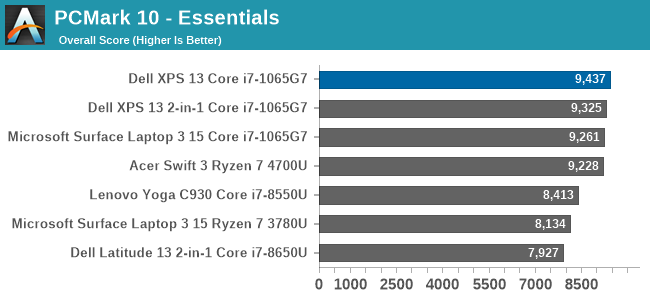
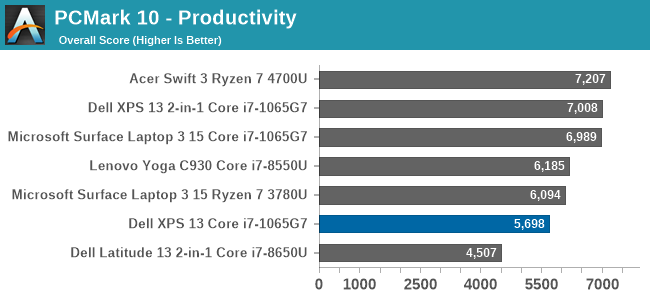
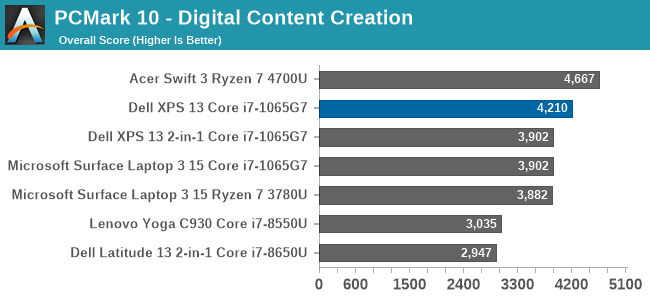
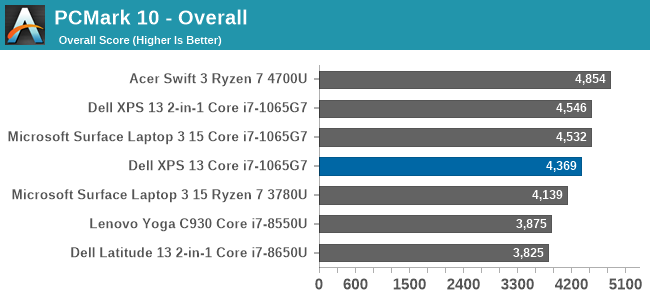
UL’s PCMark 10 is a whole-system benchmark, testing everything from CPU performance to app loading time. The Overall score consists of three categories, each featuring their own unique sub-tests. Overall the XPS 13 scored right in the same ballpark as other Ice Lake notebooks, although was slightly down in the Productivity tests, but slightly ahead in the other two.
Cinebench
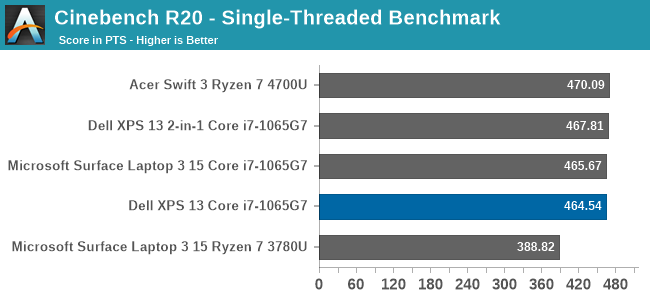
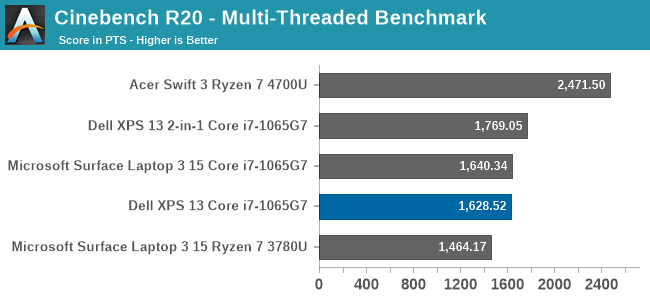
Cinebench, based on Maxon’s Cinema 4D rendering, allows tests of both single-threaded and multi-threaded runs, making it one of the more popular tests for overall computational performance. The XPS 13 does well compared to other Ice Lake equipped notebooks, although with AMD offering up to 8 cores in the same 15-Watt TDP, Intel falls behind in the multi-threaded run.
Handbrake
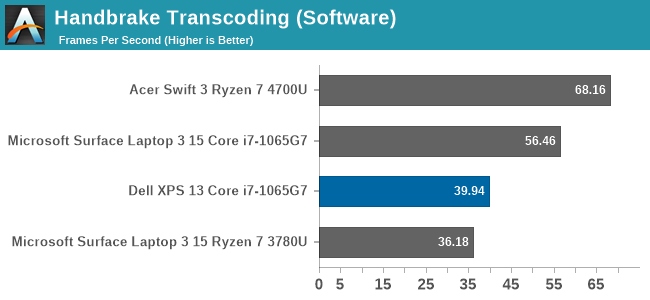
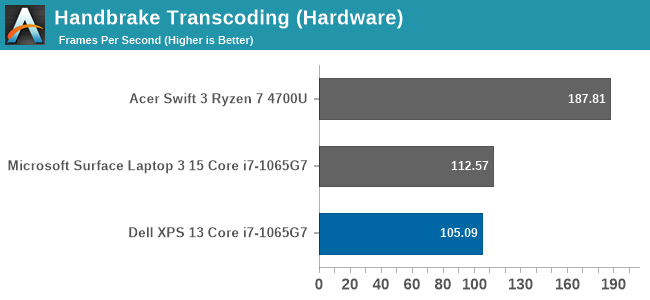
In our Handbrake encoding test, we transcode a 1080p movie to 720p using both software and hardware encoders. Software encoders utilize the CPU, and are generally the preferred method for optimal quality, whereas hardware encoders leverage the media blocks, which in this case is Intel’s QuickSync, for a much faster encode. As we will see more in the thermals section, Dell limits the XPS 13 to a 15-Watt TDP even in its maximum performance mode, where some other manufacturers will allow for higher than listed TDP, up to 20 Watts or so, and as such, the XPS 13 falls a bit behind other Ice Lake notebooks in this test which is TDP limited.
7-Zip


The popular file compression and decompression tool 7-Zip includes a built-in benchmark, and once again the XPS 13 slots right into where other Ice Lake notebooks fit.
Web Tests
Web performance is a function of not only the CPU performance, but also the browser’s scripting engine, and as such we have standardized on the Microsoft Edge browser. Microsoft has now transitioned their browser to the open-source Chromium project. Due to this, we have reset our web tests to use the new Chromium based Edge and taken the opportunity to decommission some of the older tests. We will now focus on Speedometer 2.0 and WebXPRT 3.
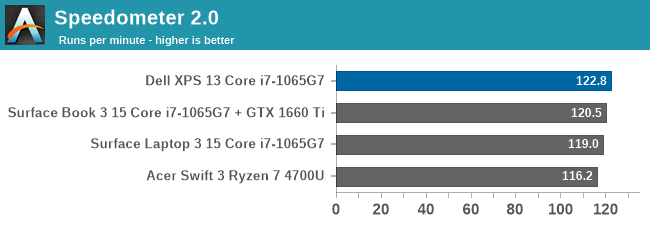
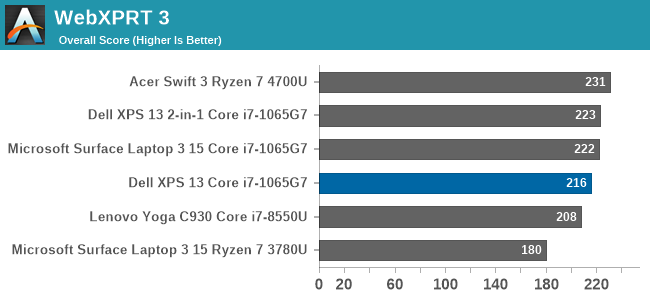
The XPS 13 again slots right in where you would expect for an i7-1065G7 based system.
Storage Performance
Dell offers from 256 GB to 2 TB of PCIe storage, and the review unit was outfitted with the Intel 600p 512 GB drive. We are transitioning to the PCMark 10 storage benchmark, which uses test traces of actual common workloads, such as booting Windows, and many of the Adobe applications, and as such should be a much better indicator of drive performance than just maximum transfer rates.
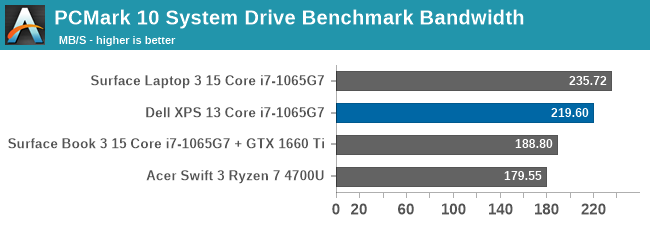
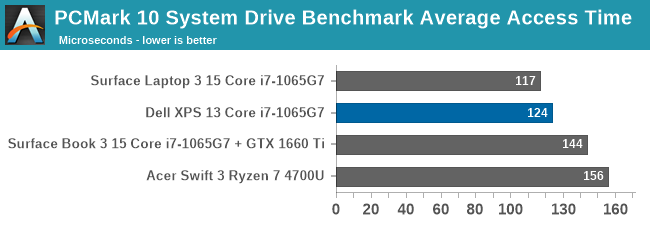

The Intel 600p performs quite well, with good access times and solid bandwidth. Surprisingly, it can’t quite match the excellent performance we saw from the SK Hynix 2230 form factor SSD in the Surface Laptop 3, but almost matches it.











224 Comments
View All Comments
gescom - Friday, July 17, 2020 - link
You have a kind of sick desperation in your laugh.https://www.notebookcheck.net/Lenovo-ThinkPad-T14s...
Korguz - Friday, July 17, 2020 - link
gescom, more like a sick desperation to keep praising his god intel, and to bash amd any chance he can.ikjadoon - Thursday, July 16, 2020 - link
IIRC, this was not mentioned by Anandtech, but this laptop (and many, many, many, many) others from the premium Ultrabook category are partnered directly with Intel through the Project Athena program, aka the "Engineered for Mobile Performance" badge you sometimes see.It gives a lot of manufacturing / R&D support while also demanding a minimum set of specifications; I think, in the end, it's a win for OEMs as they get a better product (a virtuous cycle) and they get R&D support directly from Intel on the entire notebook (not just the CPU or wireless).
I think 9/10 premium Ultrabooks are Project Athena certified.
I do believe AMD has launched a rival program with Renoir, but it may take time to gain traction. Tiger Lake vs Zen3-based mobile is going to be exciting and AMD absolutely deserves far better than the relatively average performers they keep getting stuck with.
See Anandtech's reporting here: https://www.anandtech.com/show/14444/intels-projec...
TheinsanegamerN - Thursday, July 16, 2020 - link
I've said for years that AMD needs to partner with a smaller brand like MSI or Clevo and show the world what a proper AMD notebook looks like.I was saying this back in the Llano days where nobody wanted to make a ultrabook style laptop with the A8-3500mx.
jeremyshaw - Thursday, July 16, 2020 - link
They did, with HP, a company with historically strong AMD ties in their consumer line. It didn't go well. Whomever thought bulldozer on netbooks was a good idea, is hopefully no longer calling shots at AMD or HP anymore.eastcoast_pete - Thursday, July 16, 2020 - link
I made the mistake of buying one, and it was bad. The sooner that whole period is buried and forgotten, the better for AMD.lmcd - Thursday, July 16, 2020 - link
If you're referring to the entire Bulldozer family history, I gotta say my Toshiba Satellite with an A8-4500M was actually pretty solid for a number of years. Yea the battery life was trash but performance held up for years, especially with dual-channel memory that I upgraded it to.drothgery - Thursday, July 16, 2020 - link
Depends what they think AMD and Intel will be offering next year, I'd imagine.Most vendors wouldn't have even started designing an AMD premium notebook until after they had real performance and power usage data on Ryzen 4xxx, and even then wouldn't bother unless they were fairly confident Intel wouldn't be able to match it fairly soon.
Cinebench multithread (and other embarrassingly parallel benchmarks) notwithstanding, there's really not much value in more than 4 core/8 threads for most consumers (servers and workstations are another matter); Amdhal's law is still real. But the optics of selling 4 cores vs 8 aren't great, and at least initially, Tiger Lake U will still be a quad core.
Spunjji - Friday, July 17, 2020 - link
"Most vendors wouldn't have even started designing an AMD premium notebook until after they had real performance and power usage data on Ryzen 4xxx"They would have had that data a long time before the platform shipped - Asus couldn't have designed the class-redefining Zephyrus 14 without it. They managed to create a whole new category of gaming sub-notebook, yet most of the larger OEMs couldn't manage to get one into an existing Ultrabook chassis. 🤔
Deicidium369 - Friday, July 17, 2020 - link
Yeah agree there - the OEMs have had access to the specifics of Renoir - but likely will repurpose previous designs, since Renoir is largely like the previous (3xxx APUs, don't know the names) - from an electrical and packaging point of view.I can't imagine having a laptop as a gaming platform - Opus Magnum maybe - but not BF5. But every use case is different - there used to be a DTR slot in my lineup - but not any more.